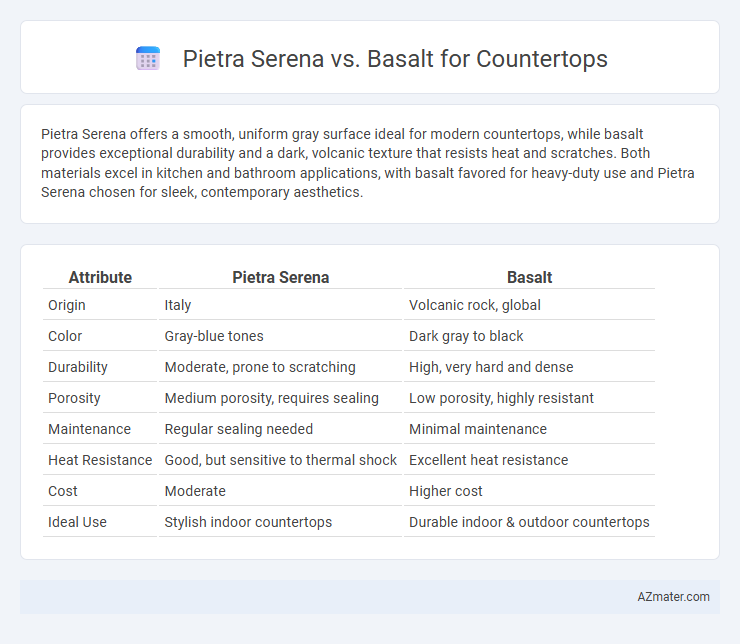Pietra Serena offers a smooth, uniform gray surface ideal for modern countertops, while basalt provides exceptional durability and a dark, volcanic texture that resists heat and scratches. Both materials excel in kitchen and bathroom applications, with basalt favored for heavy-duty use and Pietra Serena chosen for sleek, contemporary aesthetics.
Table of Comparison
| Attribute | Pietra Serena | Basalt |
|---|---|---|
| Origin | Italy | Volcanic rock, global |
| Color | Gray-blue tones | Dark gray to black |
| Durability | Moderate, prone to scratching | High, very hard and dense |
| Porosity | Medium porosity, requires sealing | Low porosity, highly resistant |
| Maintenance | Regular sealing needed | Minimal maintenance |
| Heat Resistance | Good, but sensitive to thermal shock | Excellent heat resistance |
| Cost | Moderate | Higher cost |
| Ideal Use | Stylish indoor countertops | Durable indoor & outdoor countertops |
Introduction to Pietra Serena and Basalt Countertops
Pietra Serena countertops showcase a distinct gray-blue tone with fine grain, widely valued in Tuscan architecture for its elegant, smooth finish and natural veining, making it a sophisticated choice for interior spaces. Basalt countertops, formed from volcanic lava, offer exceptional durability and a sleek, black surface with subtle texture, known for their high resistance to heat and wear. Both materials provide unique aesthetic and functional properties, suitable for different design preferences and performance requirements in kitchen and bathroom applications.
Origin and Geological Formation
Pietra Serena is a fine-grained sandstone primarily quarried in Tuscany, Italy, formed from sediment deposits in ancient river basins during the Middle Jurassic period. Basalt is an extrusive igneous rock originating from rapidly cooled lava flows, commonly found in volcanic regions worldwide, including the Columbia Plateau in the USA and the Deccan Traps in India. The sedimentary origin of Pietra Serena results in a smooth texture and unique bluish-gray tone, while basalt's volcanic formation provides a dense, hard, and durable surface ideal for countertops.
Appearance and Color Variations
Pietra Serena showcases a soft, smoky gray appearance with subtle blue undertones and fine grain textures, creating an elegant and timeless look for countertops. Basalt offers a more intense, deep black or dark gray color with a uniform, fine-grained surface that emphasizes a modern and sleek aesthetic. The color variations in Pietra Serena tend to be more diverse and nuanced, while Basalt provides consistent darkness ideal for bold, dramatic kitchen designs.
Durability and Strength Comparison
Pietra Serena, a fine-grained sandstone, offers moderate durability and strength suitable for light to medium use countertops but is more prone to scratching and staining compared to basalt. Basalt, an igneous volcanic rock, demonstrates superior hardness, remarkable resistance to heat, impact, and wear, making it an exceptionally durable choice for high-traffic kitchen surfaces. When durability and strength are the priority, basalt outperforms Pietra Serena, providing long-lasting performance and minimal maintenance over time.
Stain and Heat Resistance
Pietra Serena, a fine-grained sandstone, offers moderate stain resistance but requires sealing to protect against oil and acidic substances, while its heat resistance is sufficient for normal kitchen use but can be compromised by sudden temperature changes. Basalt, an igneous volcanic rock, excels in both stain and heat resistance due to its dense, non-porous structure, making it highly durable against spills and high temperatures. For countertop surfaces in busy kitchens, basalt provides superior long-term performance with minimal maintenance compared to Pietra Serena.
Maintenance Requirements
Pietra Serena countertops require regular sealing and gentle cleaning with pH-neutral products to prevent staining and preserve their matte finish. Basalt countertops offer low maintenance with high resistance to scratches and heat, needing only occasional sealing and mild soap cleaning. Both materials benefit from avoiding harsh chemicals and abrasive tools to maintain their durability and appearance over time.
Cost and Availability
Pietra Serena offers a moderate price point due to its unique Italian origin and limited quarry sources, making it less readily available than basalt. Basalt countertops are generally more affordable and widely accessible, thanks to abundant global deposits and robust quarrying operations. Cost efficiency and consistent availability make basalt a preferred choice for budget-conscious projects seeking durable, natural stone surfaces.
Environmental Impact
Pietra Serena, a natural sandstone quarried primarily in Tuscany, features lower embodied energy due to its local extraction and minimal processing, resulting in a reduced carbon footprint compared to basalt. Basalt, an igneous volcanic rock, often involves more energy-intensive quarrying and transportation because it is less commonly sourced near urban centers, increasing its environmental impact. Both stones are durable and long-lasting, which contributes to sustainability by reducing the need for frequent replacement, but Pietra Serena's regional availability typically makes it the more eco-friendly choice for countertops.
Design Versatility and Applications
Pietra Serena offers a soft, elegant gray tone with subtle veining, making it highly versatile for modern and classic countertop designs, while Basalt features a deep, uniform black or dark gray that suits minimalist and industrial aesthetics. Pietra Serena's natural variations lend themselves well to kitchen islands, bathroom vanities, and fireplace surrounds, offering a warm, timeless appeal. Basalt's dense, durable surface is favored for high-traffic and outdoor countertops, providing durability and a sleek, contemporary look.
Final Verdict: Choosing Between Pietra Serena and Basalt
Pietra Serena offers a classic Renaissance-era aesthetic with smooth gray tones and subtle veining, ideal for timeless, elegant countertops, while basalt provides superior durability, heat resistance, and a dense, dark surface perfect for modern, heavy-use kitchens. Basalt's high compression strength and non-porous nature make it more resistant to stains, scratches, and heat damage compared to the slightly softer, more porous Pietra Serena. Choosing between Pietra Serena and basalt hinges on the balance between artistic appeal and functional longevity, with basalt favored for high-performance, low-maintenance surfaces and Pietra Serena for distinctive, historic charm.

Infographic: Pietra Serena vs Basalt for Countertop
 azmater.com
azmater.com